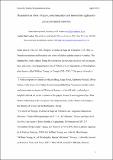Files in this item
Reputation in a box. Objects, communication and trust in late 18th-century botanical networks
Item metadata
| dc.contributor.author | Easterby-Smith, Sarah | |
| dc.date.accessioned | 2016-03-03T17:40:02Z | |
| dc.date.available | 2016-03-03T17:40:02Z | |
| dc.date.issued | 2015-06-01 | |
| dc.identifier | 27728032 | |
| dc.identifier | 3efc4d3c-5321-4580-8389-88f4929b1985 | |
| dc.identifier | 84938916306 | |
| dc.identifier | 000359145400004 | |
| dc.identifier.citation | Easterby-Smith , S 2015 , ' Reputation in a box. Objects, communication and trust in late 18th-century botanical networks ' , History of Science , vol. 53 , no. 2 , pp. 180-208 . https://doi.org/10.1177/0073275315580961 | en |
| dc.identifier.issn | 0073-2753 | |
| dc.identifier.other | ORCID: /0000-0003-1784-1255/work/27076315 | |
| dc.identifier.uri | https://hdl.handle.net/10023/8360 | |
| dc.description | Research was supported by a Max Weber Fellowship at the European University Institute, and a Dibner Fellowship in the History of Science at the Huntington Library. | en |
| dc.description.abstract | This paper examines how and why information moved or failed to move within transatlantic botanical networks in the late eighteenth century. It addresses the problem of how practitioners created relationships of trust, and the difficulties they faced in transferring reputations between national contexts. Eighteenth-century botany was characteristically cross-cultural, cosmopolitan and socially diverse, yet in the 1770s and 1780s the American Revolutionary Wars placed these attributes under strain. The paper analyses the British and French networks that surrounded the Philadelphian plant hunter William Young (1742–1785), to show how botanists and plant collectors created and maintained connections with each other, especially when separated by geographical and cultural distance. It highlights in particular the role played by commercial plant traders, and demonstrates how practitioners used objects to transmit social as well as scholarly information. The transnational circulation of information and knowledge in the Enlightenment was determined by culturally specific judgements about trust, confidence, communication and risk. Despite the prominent role played by material culture within these networks, scholars continued to place high value on face-to-face contact as a means of judging the trustworthiness and cooperation of their agents. | |
| dc.format.extent | 5541174 | |
| dc.language.iso | eng | |
| dc.relation.ispartof | History of Science | en |
| dc.subject | American Revolution | en |
| dc.subject | Botany | en |
| dc.subject | Britain | en |
| dc.subject | Commerce | en |
| dc.subject | Cosmopolitanism | en |
| dc.subject | France | en |
| dc.subject | Material culture | en |
| dc.subject | Networks | en |
| dc.subject | Reputation | en |
| dc.subject | Trust | en |
| dc.subject | D204 Modern History | en |
| dc.subject | BDC | en |
| dc.subject | R2C | en |
| dc.subject.lcc | D204 | en |
| dc.title | Reputation in a box. Objects, communication and trust in late 18th-century botanical networks | en |
| dc.type | Journal article | en |
| dc.contributor.institution | University of St Andrews. School of History | en |
| dc.identifier.doi | https://doi.org/10.1177/0073275315580961 | |
| dc.description.status | Peer reviewed | en |
This item appears in the following Collection(s)
Items in the St Andrews Research Repository are protected by copyright, with all rights reserved, unless otherwise indicated.

